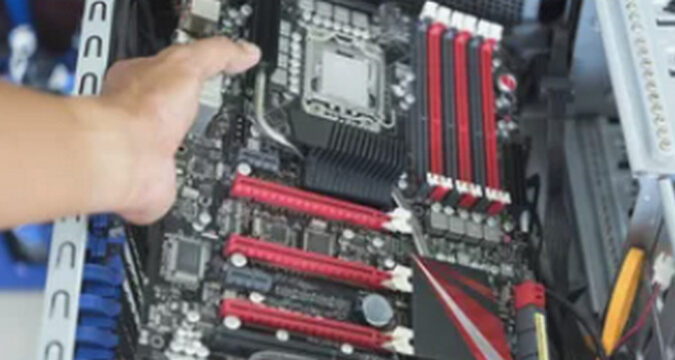
When assembling a PC, choosing a motherboard is essential since it affects your system’s compatibility and capacity. To help you with the decision process, the following seven crucial elements should be taken into account when selecting a motherboard:
1. Form Factor
A motherboard’s size and the kinds of cases it can fit into are determined by its form factor. The most prevalent form variables are:
ATX: Standard sized, with lots of room for expansions and components.
Smaller than ATX, Micro-ATX can fit into smaller cases but has fewer expansion slots.
Compact and perfect for tiny projects, mini-ITX systems have few possibilities for expansion.
Take into account: Make sure the form factor fits the size of your case. In order to optimise performance for gaming or workstation builds, an ATX motherboard offers superior heat dissipation and more slots. Compact builds or HTPCs are a good fit for Mini-ITX.
2. Type of Socket
The motherboard’s CPU socket needs to be compatible with the processor you intend to utilise. The primary kinds are:
Intel: LGA 1700 and LGA 1200.
AMD: AM4, AM5.
Take into account: Select a motherboard whose socket can accommodate the particular CPU you want to utilise. For example, a motherboard with an LGA 1700 socket is needed for an Intel i9-12900K.
3. Chipset
The motherboard’s features and compatibility with CPUs, RAM, and expansion cards are determined by the chipset. Typical chipsets consist of:
Intel: H610, Z690, and B660
AMD: B550, A520, and X570
A higher-end chipset, such as the Z series from Intel or the X series from AMD, will have more features, like increased PCIe lanes, improved networking, and greater support for overclocking. Basic setups can benefit from low-cost chipsets such as AMD’s A series or Intel’s H series.
4. RAM Interoperability
Certain kinds and quantities of RAM are supported by motherboards:
DDR4 vs. DDR5: Newer motherboards could be able to accommodate DDR5, which is more expensive but offers superior performance.
Maximum Capacity: Up to 128GB is supported by the majority of motherboards, while higher-end models might support more.
Speed: Verify that the motherboard can accommodate the desired RAM speed.
Think about it: Pick a motherboard that can accommodate the kind and quantity of RAM you require. 16–32GB of DDR4 is plenty for everyday use and gaming. Take into consideration DDR5 support for high-end applications or future-proofing.
5. Connectivity and Expansion Slots
For upcoming updates, the quantity and kind of expansion slots are crucial:
PCIe Slots: Used for expansion cards, SSDs, and graphics cards.
M.2 Slots: Designed for fast NVMe SSDs.
SATA ports: To accommodate extra hard drives.
Consideration: If you intend to use several GPUs or other expansion cards, make sure the motherboard has enough PCIe slots for your needs. If you intend to use NVMe SSDs for speedier storage, be sure they have M.2 slots.
6. Options for Connectivity
There are numerous connecting options available on modern motherboards:
USB ports: USB-C and USB 3.2 are available for quicker data transfer.
Networking: support for Wi-Fi and Ethernet interfaces.
Audio: Surround sound compatibility and high-quality onboard sound.
Think about: Assess your requirements for connectivity. For example, select a motherboard with Wi-Fi 6 if you require high-speed internet. Look for many high-speed USB ports and high-quality audio components while creating content.
7. UEFI and BIOS
For system configuration and updates, the UEFI (Unified Extensible Firmware Interface) or BIOS (Basic Input/Output System) is essential:
Ease of Use: Newer UEFI interfaces offer sophisticated functionality and are easier to use.
BIOS settings for simple overclocking are known as overclocking.
upgrades: Firmware upgrades are supported in order to keep new hardware compatible.
Consideration: If you intend to modify system settings or do overclocking, pick a motherboard featuring an intuitive UEFI interface. Updating your BIOS on a regular basis is essential for keeping your system secure.
Extra Things to Think About
Name and Guarantee
reputable companies such as ASUS, MSI, Gigabyte, and ASRock are known for their higher quality customer service and more dependable goods. Think about the warranty duration and the customer service track record of the business.
Phases of Power and Cooling
Better stability and performance are provided by motherboards with additional power phases and sturdy cooling systems, particularly while overclocking. Seek for motherboards with sufficient cooling options and heatsinks on the VRMs (Voltage Regulator Modules).
Design and Construction Quality
Take into account the motherboard’s aesthetics, like as colour schemes and RGB lighting, if you’re interested in making your PC build visually appealing. Verify the materials and build quality as well.
Spending Plan
Your decision will be greatly influenced by your budget. While the most features and optimal performance are found in high-end motherboards, many users may find that budget or mid-range models will suffice. To get the greatest deal, weigh the qualities you require against the price.
In summary
When choosing a motherboard, it is important to take into account a number of important elements, such as form factor, socket type, chipset, compatibility of RAM, expansion slots, connectivity choices, and BIOS/UEFI capabilities. You can make sure that your motherboard will fulfil your requirements and accommodate future upgrades by carefully weighing these factors, giving your PC design a strong foundation. To make an informed choice, don’t forget to take into account factors like warranty, cooling, power phases, cooling, brand reputation, and your budget.